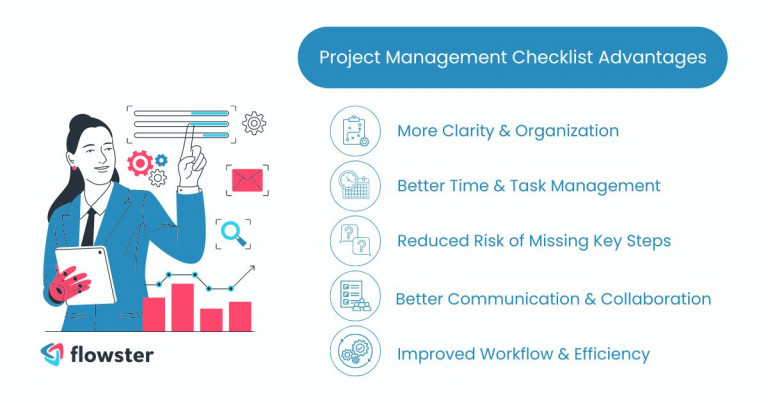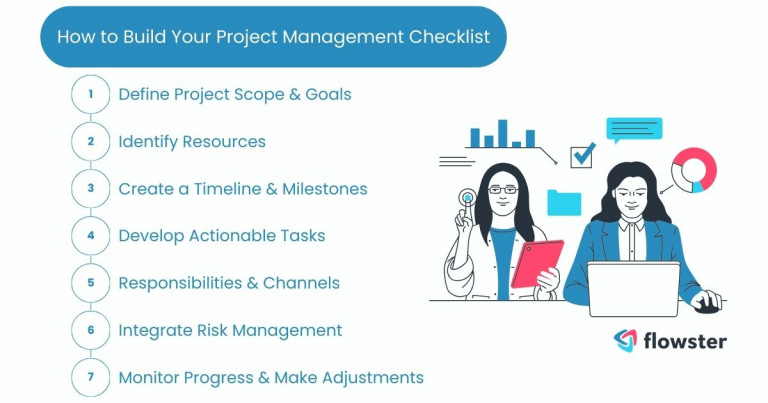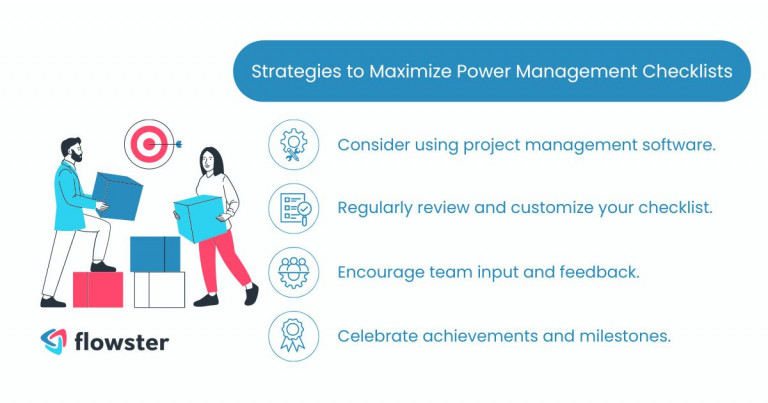Do you ever feel like your projects are drowning in a sea of sticky notes and to-do lists? You scramble to meet deadlines, information gets lost in the shuffle, and frustration mounts as tasks pile up.
This chaotic scenario is a common struggle for many project managers. But what if there was a tool that could streamline your workflow, keep you organized, and ensure nothing fell through the cracks? Enter the powerful project management checklist.
A well-crafted checklist acts as a roadmap for your project, ensuring every step is accounted for and completed on time. This simple tool can have a dramatic impact on your project’s success. By using a management checklist, you’ll improve organization, prioritize tasks more effectively, and ultimately achieve better results.
Article Outline
Why Use a Project Management Checklist?
Imagine a world where your projects run smoothly, deadlines are met with ease, and your team is always on the same page. This utopia of project management is entirely achievable with the help of a powerful tool: the project management checklist.
But why exactly are checklists so beneficial? Here’s a breakdown of the key advantages that will have you reaching for a checklist for every project you tackle:
- Increased Organization and Clarity: A well-structured management checklist lays out all the crucial steps involved in your project, from initial planning to final delivery. This clear roadmap eliminates confusion and ensures everyone involved understands the project’s scope and expectations.
- Improved Task Prioritization and Time Management: Checklists help you break down large projects into smaller, more manageable tasks. This allows you to prioritize effectively, allocate time and resources efficiently, and stay on top of deadlines. No more scrambling to meet last-minute deadlines or wondering what needs to be done next.
- Reduced Risk of Overlooking Essential Steps: The human brain is fallible, and even the most experienced project manager can miss something important. A checklist acts as a safety net, ensuring you don’t overlook critical tasks or details that could derail your project.
- Enhanced Communication and Collaboration: When everyone involved in the project is working from the same checklist, communication becomes smoother and more efficient. The checklist ensures clear expectations and eliminates misunderstandings, fostering a collaborative team environment.
Streamlined Workflow and Boosted Efficiency: Checklists streamline your project workflow by keeping everyone focused on the essential tasks at hand. This eliminates wasted time and helps you achieve more in less time. By reducing the mental load of remembering every detail, checklists free up your cognitive resources for more strategic thinking and problem-solving.
Now that you understand the power of a project management checklist, let’s dive into the specifics of building your own. In the next section, we’ll walk you through the process of creating a customized checklist that will become your go-to tool for project success.

Building Your Project Management Checklist: A Step-by-Step Guide
A well-defined project management checklist is a project manager’s secret weapon. It keeps everyone on the same page, ensures tasks are completed on time, and helps mitigate potential risks. This step-by-step guide will walk you through building a customized checklist to keep your project running smoothly.
Step 1: Define Project Scope and Goals
- Clearly Defined Objectives and Deliverables: The foundation of any good checklist is a clear understanding of what the project aims to achieve. Start by outlining your project goals and the specific deliverables that will indicate success. This clarity will guide the creation of actionable tasks within your project management checklist.
- Breaking Down Large Projects: Complex projects can feel overwhelming. To make them more manageable, break them down into smaller, achievable phases. This will help you identify key milestones and create a more detailed roadmap for your project checklist.
Step 2: Identify Resources
- People, Budget, and Tools: No project succeeds in a vacuum. To effectively complete your project, you’ll need to identify the necessary resources, including personnel with the right skills, a clearly defined budget, and the tools required to get the job done.
- Resource Allocation and Scheduling: Once you’ve identified your resources, consider how you’ll allocate them throughout the project. This might involve scheduling personnel time, managing equipment availability, and ensuring your budget is spent efficiently.
Step 3: Create a Timeline and Milestones
- Setting Realistic Deadlines: A successful project adheres to a realistic timeline. Set clear deadlines for each task and project phase within your checklist. This will keep everyone accountable and focused on achieving goals on time.
- Milestones as Benchmarks: Milestones are key achievements within a project that mark significant progress. Including these milestones in your checklist provides a clear picture of where the project stands and helps identify any potential delays early on.
- Popular Project Scheduling Methods: There are various project scheduling methods, such as Gantt charts, that can help visualize your timeline. Choose a method that best suits your project and integrate it into your checklist for a clear visual representation of deadlines and milestones.
Step 4: Develop Actionable Tasks
- Clear, Concise, and Actionable: The heart of your project management checklist lies in the tasks themselves. Each task should be clear, concise, and actionable. This means it should be easily understood and provide a specific action for team members to complete.
- Breaking Down Complex Tasks: Large or complex tasks can be daunting. Your checklist can help by breaking them down into smaller, more manageable steps. This will make the project seem less overwhelming and ensure every aspect is addressed.
Flowster's AI-Driven Automation
Step 5: Assign Responsibilities and Communication Channels
- Clear Ownership and Accountability: A strong project management checklist assigns clear ownership for each task. This ensures everyone knows who is responsible for completing specific actions and avoids confusion down the line.
- Assigning Tasks Based on Skills: When assigning tasks, consider the skills and expertise of your team members. Matching tasks to strengths will optimize efficiency and ensure the project benefits from everyone’s unique abilities.
- Communication Channels for Updates and Feedback: A well-defined communication plan is crucial for a successful project. Your checklist should establish clear communication channels for team members to provide updates, ask questions, and offer feedback. This fosters collaboration and keeps everyone informed.
Step 6: Integrate Risk Management
- Identifying and Mitigating Risks: No project exists in a perfect bubble. Unexpected challenges can arise. Your checklist can be a valuable tool for risk management. By identifying potential risks and including contingency plans within the checklist, you’ll be better prepared to navigate unforeseen roadblocks.
- Adding Potential Risks and Contingency Plans: Taking the time to brainstorm potential risks and outline mitigation strategies demonstrates proactive planning. Including these elements in your checklist allows you to address potential problems before they derail your project.
Step 7: Monitor Progress and Make Adjustments
- Regular Review and Progress Tracking: A project management checklist is a dynamic tool. Schedule regular reviews to assess progress and ensure tasks are on track. Utilize your checklist to track completions and identify any areas where the project might be falling behind.
- Identifying Roadblocks and Adapting Plans: Your checklist can act as an early warning system. If you notice delays or roadblocks during your review, use the checklist to identify the source of the problem and adapt your plan accordingly. This proactive approach will help you stay on course and achieve your project goals.
By following these steps and incorporating the valuable tips provided, you can build a customized project management checklist that keeps your project on track and ensures success. The next section offers further strategies to optimize your checklist and maximize its effectiveness.

Additional Tips for Effective Checklist Management
Now that you have a robust project management checklist in place, here are some additional strategies to maximize its effectiveness and keep your project running smoothly:
- Leveraging Technology: Consider using project management software or online tools designed to create and collaborate on checklists. These tools offer features like task assignment, progress tracking, and communication channels, all integrated within the checklist itself.
- Customization is Key: A one-size-fits-all approach rarely works well with project management checklists. Regularly review and customize your checklist based on the specific needs of your project and the dynamics of your team. This ensures the checklist remains relevant and addresses the unique challenges of each project phase.
- Embrace Collaboration: Don’t view your checklist as a static document. Encourage team input and feedback throughout the project lifecycle. This collaborative approach can help identify areas for improvement and ensure the checklist remains valuable for everyone involved.
- Celebrating Success: Maintaining motivation and team morale is essential for project success. Celebrate achievements and milestones along the way. Acknowledging progress keeps your team engaged and reinforces the effectiveness of your project management checklist.
By following these additional tips, you can transform your project management checklist from a simple to-do list into a powerful tool for project success. In the next section, we’ll summarize the key takeaways and emphasize the overall value of a well-crafted project management checklist.

Unleash the Power: The Final Word on Project Management Checklists
A well-crafted project management checklist is a project manager’s secret weapon. By following the steps outlined above, you can create a customized checklist that keeps your project organized, on track, and focused on achieving success.
Key Takeaways:
- A strong management checklist provides clarity on project goals, tasks, and deadlines.
- It promotes accountability, streamlines communication, and helps mitigate potential risks.
- Regularly reviewed and updated checklists ensure your project remains adaptable and responsive to changing circumstances.
Ready to harness the power of project management checklists in your own projects? Don’t wait! Take the first step towards creating your own success story.
Get Started Today: Free Management Checklist Templates Available!
Flowster Marketplace offers a variety of free management checklist templates and other resources to jumpstart your project planning. Get started building your customized checklist today and experience the benefits firsthand!
Looking for a head start? Flowster also offers a range of “Done-for-You” services, where our team of experts can create a tailored project management checklist specifically for your unique needs. Visit Flowster Marketplace to learn more and unlock the full potential of your projects!




